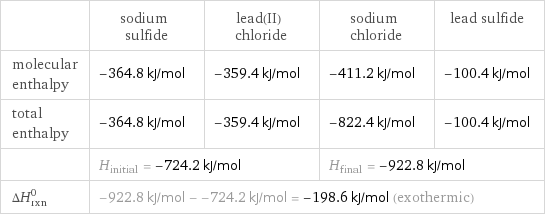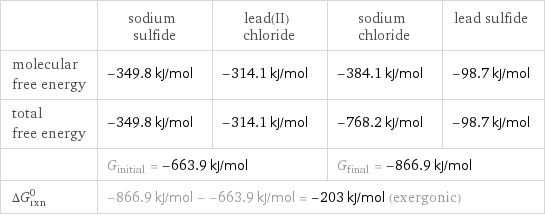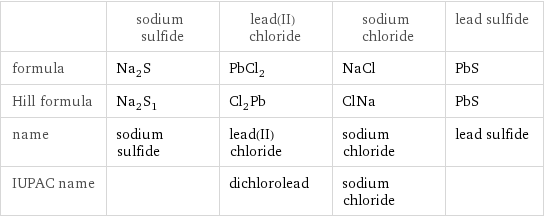Input interpretation

Na_2S sodium sulfide + PbCl_2 lead(II) chloride ⟶ NaCl sodium chloride + PbS lead sulfide
Balanced equation

Balance the chemical equation algebraically: Na_2S + PbCl_2 ⟶ NaCl + PbS Add stoichiometric coefficients, c_i, to the reactants and products: c_1 Na_2S + c_2 PbCl_2 ⟶ c_3 NaCl + c_4 PbS Set the number of atoms in the reactants equal to the number of atoms in the products for Na, S, Cl and Pb: Na: | 2 c_1 = c_3 S: | c_1 = c_4 Cl: | 2 c_2 = c_3 Pb: | c_2 = c_4 Since the coefficients are relative quantities and underdetermined, choose a coefficient to set arbitrarily. To keep the coefficients small, the arbitrary value is ordinarily one. For instance, set c_1 = 1 and solve the system of equations for the remaining coefficients: c_1 = 1 c_2 = 1 c_3 = 2 c_4 = 1 Substitute the coefficients into the chemical reaction to obtain the balanced equation: Answer: | | Na_2S + PbCl_2 ⟶ 2 NaCl + PbS
Structures

+ ⟶ +
Names

sodium sulfide + lead(II) chloride ⟶ sodium chloride + lead sulfide
Reaction thermodynamics
Enthalpy

| sodium sulfide | lead(II) chloride | sodium chloride | lead sulfide molecular enthalpy | -364.8 kJ/mol | -359.4 kJ/mol | -411.2 kJ/mol | -100.4 kJ/mol total enthalpy | -364.8 kJ/mol | -359.4 kJ/mol | -822.4 kJ/mol | -100.4 kJ/mol | H_initial = -724.2 kJ/mol | | H_final = -922.8 kJ/mol | ΔH_rxn^0 | -922.8 kJ/mol - -724.2 kJ/mol = -198.6 kJ/mol (exothermic) | | |
Gibbs free energy

| sodium sulfide | lead(II) chloride | sodium chloride | lead sulfide molecular free energy | -349.8 kJ/mol | -314.1 kJ/mol | -384.1 kJ/mol | -98.7 kJ/mol total free energy | -349.8 kJ/mol | -314.1 kJ/mol | -768.2 kJ/mol | -98.7 kJ/mol | G_initial = -663.9 kJ/mol | | G_final = -866.9 kJ/mol | ΔG_rxn^0 | -866.9 kJ/mol - -663.9 kJ/mol = -203 kJ/mol (exergonic) | | |
Equilibrium constant
![Construct the equilibrium constant, K, expression for: Na_2S + PbCl_2 ⟶ NaCl + PbS Plan: • Balance the chemical equation. • Determine the stoichiometric numbers. • Assemble the activity expression for each chemical species. • Use the activity expressions to build the equilibrium constant expression. Write the balanced chemical equation: Na_2S + PbCl_2 ⟶ 2 NaCl + PbS Assign stoichiometric numbers, ν_i, using the stoichiometric coefficients, c_i, from the balanced chemical equation in the following manner: ν_i = -c_i for reactants and ν_i = c_i for products: chemical species | c_i | ν_i Na_2S | 1 | -1 PbCl_2 | 1 | -1 NaCl | 2 | 2 PbS | 1 | 1 Assemble the activity expressions accounting for the state of matter and ν_i: chemical species | c_i | ν_i | activity expression Na_2S | 1 | -1 | ([Na2S])^(-1) PbCl_2 | 1 | -1 | ([PbCl2])^(-1) NaCl | 2 | 2 | ([NaCl])^2 PbS | 1 | 1 | [PbS] The equilibrium constant symbol in the concentration basis is: K_c Mulitply the activity expressions to arrive at the K_c expression: Answer: | | K_c = ([Na2S])^(-1) ([PbCl2])^(-1) ([NaCl])^2 [PbS] = (([NaCl])^2 [PbS])/([Na2S] [PbCl2])](../image_source/f729dffde7580ad5054fae331adc70e4.png)
Construct the equilibrium constant, K, expression for: Na_2S + PbCl_2 ⟶ NaCl + PbS Plan: • Balance the chemical equation. • Determine the stoichiometric numbers. • Assemble the activity expression for each chemical species. • Use the activity expressions to build the equilibrium constant expression. Write the balanced chemical equation: Na_2S + PbCl_2 ⟶ 2 NaCl + PbS Assign stoichiometric numbers, ν_i, using the stoichiometric coefficients, c_i, from the balanced chemical equation in the following manner: ν_i = -c_i for reactants and ν_i = c_i for products: chemical species | c_i | ν_i Na_2S | 1 | -1 PbCl_2 | 1 | -1 NaCl | 2 | 2 PbS | 1 | 1 Assemble the activity expressions accounting for the state of matter and ν_i: chemical species | c_i | ν_i | activity expression Na_2S | 1 | -1 | ([Na2S])^(-1) PbCl_2 | 1 | -1 | ([PbCl2])^(-1) NaCl | 2 | 2 | ([NaCl])^2 PbS | 1 | 1 | [PbS] The equilibrium constant symbol in the concentration basis is: K_c Mulitply the activity expressions to arrive at the K_c expression: Answer: | | K_c = ([Na2S])^(-1) ([PbCl2])^(-1) ([NaCl])^2 [PbS] = (([NaCl])^2 [PbS])/([Na2S] [PbCl2])
Rate of reaction
![Construct the rate of reaction expression for: Na_2S + PbCl_2 ⟶ NaCl + PbS Plan: • Balance the chemical equation. • Determine the stoichiometric numbers. • Assemble the rate term for each chemical species. • Write the rate of reaction expression. Write the balanced chemical equation: Na_2S + PbCl_2 ⟶ 2 NaCl + PbS Assign stoichiometric numbers, ν_i, using the stoichiometric coefficients, c_i, from the balanced chemical equation in the following manner: ν_i = -c_i for reactants and ν_i = c_i for products: chemical species | c_i | ν_i Na_2S | 1 | -1 PbCl_2 | 1 | -1 NaCl | 2 | 2 PbS | 1 | 1 The rate term for each chemical species, B_i, is 1/ν_i(Δ[B_i])/(Δt) where [B_i] is the amount concentration and t is time: chemical species | c_i | ν_i | rate term Na_2S | 1 | -1 | -(Δ[Na2S])/(Δt) PbCl_2 | 1 | -1 | -(Δ[PbCl2])/(Δt) NaCl | 2 | 2 | 1/2 (Δ[NaCl])/(Δt) PbS | 1 | 1 | (Δ[PbS])/(Δt) (for infinitesimal rate of change, replace Δ with d) Set the rate terms equal to each other to arrive at the rate expression: Answer: | | rate = -(Δ[Na2S])/(Δt) = -(Δ[PbCl2])/(Δt) = 1/2 (Δ[NaCl])/(Δt) = (Δ[PbS])/(Δt) (assuming constant volume and no accumulation of intermediates or side products)](../image_source/88707d761ccbd9446b3a6d73b7da25a5.png)
Construct the rate of reaction expression for: Na_2S + PbCl_2 ⟶ NaCl + PbS Plan: • Balance the chemical equation. • Determine the stoichiometric numbers. • Assemble the rate term for each chemical species. • Write the rate of reaction expression. Write the balanced chemical equation: Na_2S + PbCl_2 ⟶ 2 NaCl + PbS Assign stoichiometric numbers, ν_i, using the stoichiometric coefficients, c_i, from the balanced chemical equation in the following manner: ν_i = -c_i for reactants and ν_i = c_i for products: chemical species | c_i | ν_i Na_2S | 1 | -1 PbCl_2 | 1 | -1 NaCl | 2 | 2 PbS | 1 | 1 The rate term for each chemical species, B_i, is 1/ν_i(Δ[B_i])/(Δt) where [B_i] is the amount concentration and t is time: chemical species | c_i | ν_i | rate term Na_2S | 1 | -1 | -(Δ[Na2S])/(Δt) PbCl_2 | 1 | -1 | -(Δ[PbCl2])/(Δt) NaCl | 2 | 2 | 1/2 (Δ[NaCl])/(Δt) PbS | 1 | 1 | (Δ[PbS])/(Δt) (for infinitesimal rate of change, replace Δ with d) Set the rate terms equal to each other to arrive at the rate expression: Answer: | | rate = -(Δ[Na2S])/(Δt) = -(Δ[PbCl2])/(Δt) = 1/2 (Δ[NaCl])/(Δt) = (Δ[PbS])/(Δt) (assuming constant volume and no accumulation of intermediates or side products)
Chemical names and formulas

| sodium sulfide | lead(II) chloride | sodium chloride | lead sulfide formula | Na_2S | PbCl_2 | NaCl | PbS Hill formula | Na_2S_1 | Cl_2Pb | ClNa | PbS name | sodium sulfide | lead(II) chloride | sodium chloride | lead sulfide IUPAC name | | dichlorolead | sodium chloride |